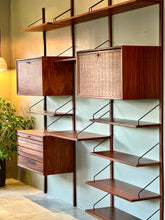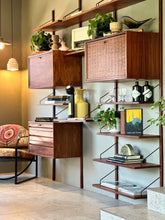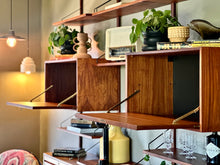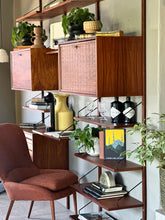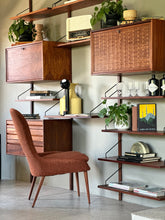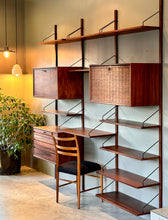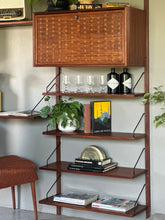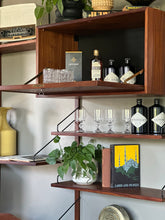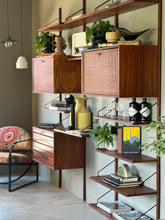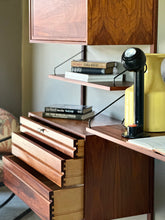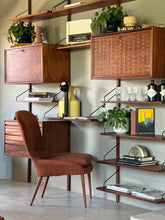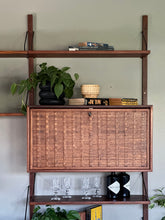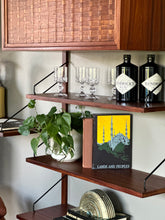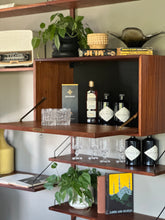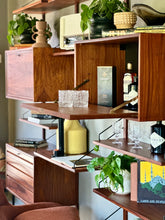
A stunning quintessential 3-Bay Mid-Century wall unit, dating back to the 1960s and displaying the iconic design synonymous with Poul Cadovius. Attributed to being a creation for Cado in Denmark, it exemplifies the craftsmanship and style distinctive to Cadovius' work during that era, reflecting the attention to detail and craftsmanship characteristic of Cadovius' work.
The adjustable nature of the wall unit allows for a customized arrangement of cabinets and shelves, providing both practical storage solutions and a visually appealing display. The unit has 10 shelves, two cabinets each with a drop front door, and a three-drawer cabinet unit.
In addition to its adjustable and modular features, it's worth noting that this wall unit is designed to be wall-mounted. This feature enhances its versatility, allowing the user to save floor space and create a sleek, floating appearance. Demonstrating an emphasis on meticulous detail and skillful craftsmanship that are distinctive traits of Cadovius' work, this highlights the design flair.
The drop-fronted cabinets do not have an inner shelf so taller objects like wine bottles will fit perfectly. It’s, of course, easy to add an inner glass shelf.
In-depth research reveals a variety of designs and versions created, with this particular one standing out as among the consistently favored choices. Poul Cadovius was a Danish furniture designer known for his innovative modular shelving systems, and the Cado series was one of his notable contributions.
This unit, with its modular and adaptable design, has stood the test of time and remains highly sought after by collectors and enthusiasts of mid-century modern furniture.
Its timeless appeal lies in its functional elegance and the ability to seamlessly blend with various interior styles while offering practical storage solutions.
The teak wood has been fully restored and sealed and it is in good condition and the steel brackets are in their original condition.
The unit consists of:
- 10 shelves
- 2 Cabinets (both are drop-fronted) One with sought-after parquetry detail
- 3-drawer Unit
- All the original and appropriate brackets to hold the units & shelves in place and
- 4 Wall-mounted, wooden uprights
Unit available to view on display
242cm W X 38cm D X 229cm H - Total assembled dimensions
2 Shelves: 80cm W X 37,5cm D X 2cm H
8 Shelves: 80cm W X 25cm D X 2cm H (two were replaced)
Drop-front cabinets: 80cm W X 37,5cm D X 42,5cm H
Drawer cabinet: 80cm W X 37,5cm D X 42,5cm H
These units typically bore a removable label, and due to the age of this unit, the label is no longer intact, a common occurrence with many mid-century items. Despite the absence of a manufacturer label, our comprehensive research substantiates that this piece showcases exceptional craftsmanship, distinctive design lines, quality hardware, and reliable wall supports.
Attributed based on extensive research & documented units across globally.
Background on Designer:
"Danish designer and manufacturer Poul Cadovius was born in Frederiksberg in 1911. Originally trained as a saddler and upholster, Cadovius became interested in industrial design and established his own furniture manufacturing company under the name of Royal Systems in 1945. Shortly after, Cadovius had the revolutionary idea to design a floating, modular shelving system that would maximize floor space and signify the end of conformity in shelving. The Royal System (1948) went on to win the gold medal at the Finland Furniture Fair in 1950 and the silver medal at the XI Triennale di Milano 1957 and remained a hallmark of midcentury modern design throughout the 1950s and ‘60s.
Sometime between 1964 and 1967, Cadovius purchased the well-established furniture manufacturer France & Søn—credited with the industrialization of teak furniture production—and eventually renamed the company CADO. Cadovius collaborated with the impressive roster of iconic Danish designers through France & Søn and CADO, including Sigvar Bernadotte, Grete Jalk, Arne Vodder, Edvard Kindt-Larsen, and Finn Juhl. Pieces manufactured by CADO include Ditte & Adrian Heath’s 594 Dining Table and Chairs (1971), Steen Ostergaard’s Lounge Chair and Model 290 Chairs (1968), Ole Wanscher’s Senator Chair series (1960s), as well as a series of coffee tables in the 1960s by Cadovius that feature the use of aluminum, rosewood, and hand-painted designs by Susan Fjedldoe Mygge.
His minimalistic aesthetic is considered a perfect harmony between form and function—industrial and organic, affordable and elegant. Although the Royal System shelving unit was his main contribution to Danish modernism, Cadovius registered more than 400 patents throughout his long career, leaving behind a legacy that inspired many future designers.
Cadovius passed away in 2011 at the age of 99".
242cm W X 38cm D X 229cm H
Shipping Information:
If you are purchasing an item and you are based in Cape Town, Durban, or any area outside Gauteng, please select the 'LOCAL PICK-UP' option at check-out and do not choose a shipment option.
Please be aware that we cannot reserve any items until transportation or shipping arrangements have been finalized. Therefore, purchasing the item and proceeding with the check-out process is important.
After your purchase is complete, you are welcome to arrange your own method of transport. If you require our assistance, we can assist you in obtaining a shipping quote based on the dimensions of the item(s) you have bought. Please email us at shop@retrend.co.za so we can provide cost estimates for shipping to your area from our preferred suppliers. For more detailed information, please refer to our shipping policy.
Note/Disclaimer:
Our images form part of the item/s description. Although all effort is made to refurbish our furniture to represent its original state best, it must be noted that most of the items we source date from the 1950s to the late 1970s. For this reason and although restored, signs of their vintage condition & age might still be visible. We will typically point out any visible/notable concerns. Take note of all photos or view the item in-store prior to purchasing.
As with most Mid-Century pieces, it is a good combination of solid wood and a high-quality wood veneer. The history of veneer on furniture is a long and honorable tradition, and it depends on the veneer's artistry, condition, and thickness. The quality of the veneer was long-lasting; for this reason, it can be retouched or sanded and refinished.




















